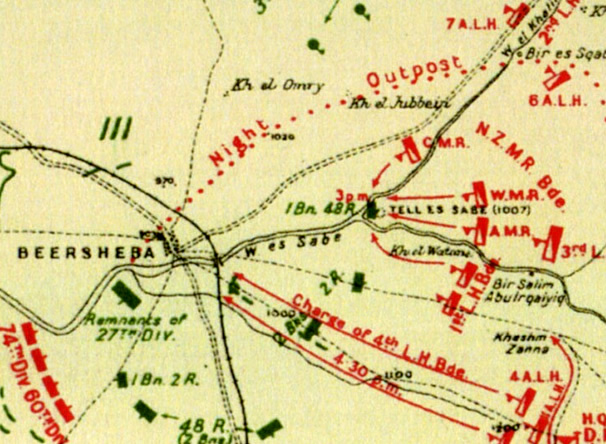
The capture of Beersheba (Be’er Sheva in modern Israel) was a turning point in the struggle between the British and Ottoman Empires in the Middle East during the First World War. The New Zealand Mounted Rifles Brigade played a key part in the capture of the town.
Twice already in 1917 the British-led Egyptian Expeditionary Force (EEF) had failed to take Gaza, the gateway to Palestine. Its third attempt focused on Beersheba, at the eastern (inland) end of the Ottomans’ defensive line. While three British infantry divisions attacked the main Ottoman defences on the outskirts of Beersheba, the Australian and Anzac mounted divisions rode in a wide arc to the east to attack the town from the rear.
On the morning of 31 October 1917 men of the New Zealand Mounted Rifles Brigade attacked Tel el Saba, a fortified hill 3.2 km north-east of Beersheba. After six hours of hard fighting the New Zealanders captured the hill. The way was now clear to attack Beersheba itself, but daylight would soon fade. In a daring action, the 4th Australian Light Horse Brigade charged in from the south-east with bayonets drawn, taking the Ottoman defenders by surprise. The town and its important wells were soon secured and the enemy retreated. By the end of the day at least eight New Zealanders had been killed and 26 wounded.
The EEF now sought to trap the main Ottoman forces defending Gaza, but lack of water and skilful rearguard actions allowed most of the enemy troops to escape. Within a week the Ottomans had abandoned Gaza, opening the door for the EEF to advance into Palestine.
Read more on NZHistory
Third Battle of Gaza – Palestine campaignAuckland Mounted Rifles Regiment – Mounted Rifles unitsCanterbury Mounted Rifles Regiment – Mounted Rifles unitsWellington Mounted Rifles Regiment – Mounted Rifles unitsBess the horse Great War Story – Great War StoriesThe Harper Brothers Great War Story – Great War Stories
External links
How to cite this page
'Capture of Beersheba', URL: https://nzhistory.govt.nz/page/capture-beersheba, (Ministry for Culture and Heritage), updated 9-Sep-2020

Community contributions